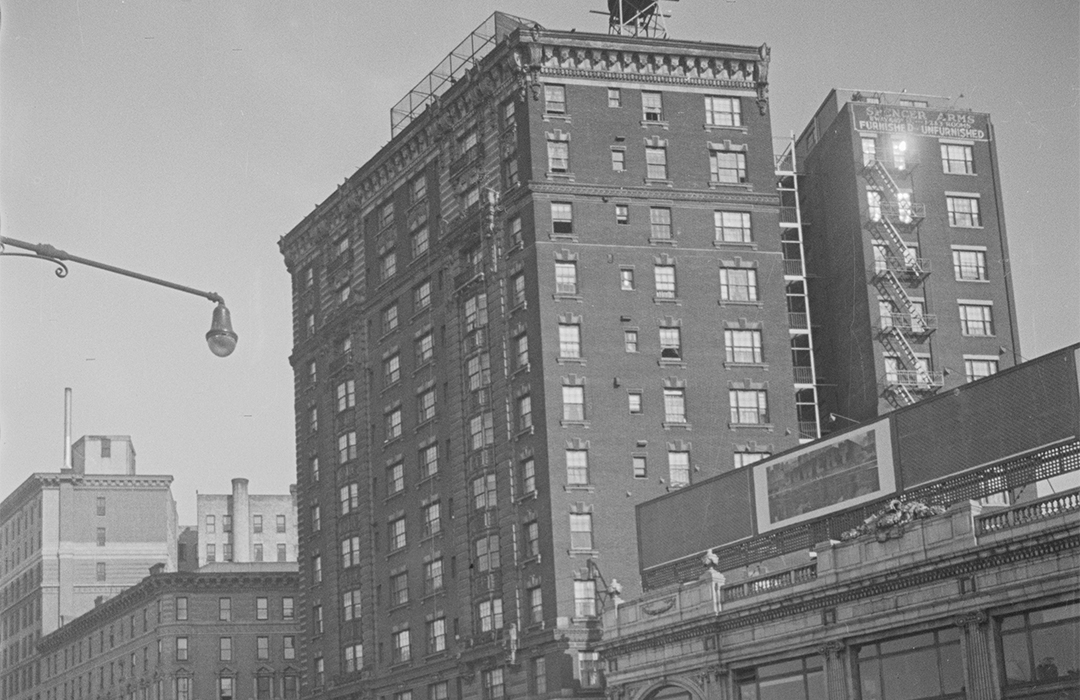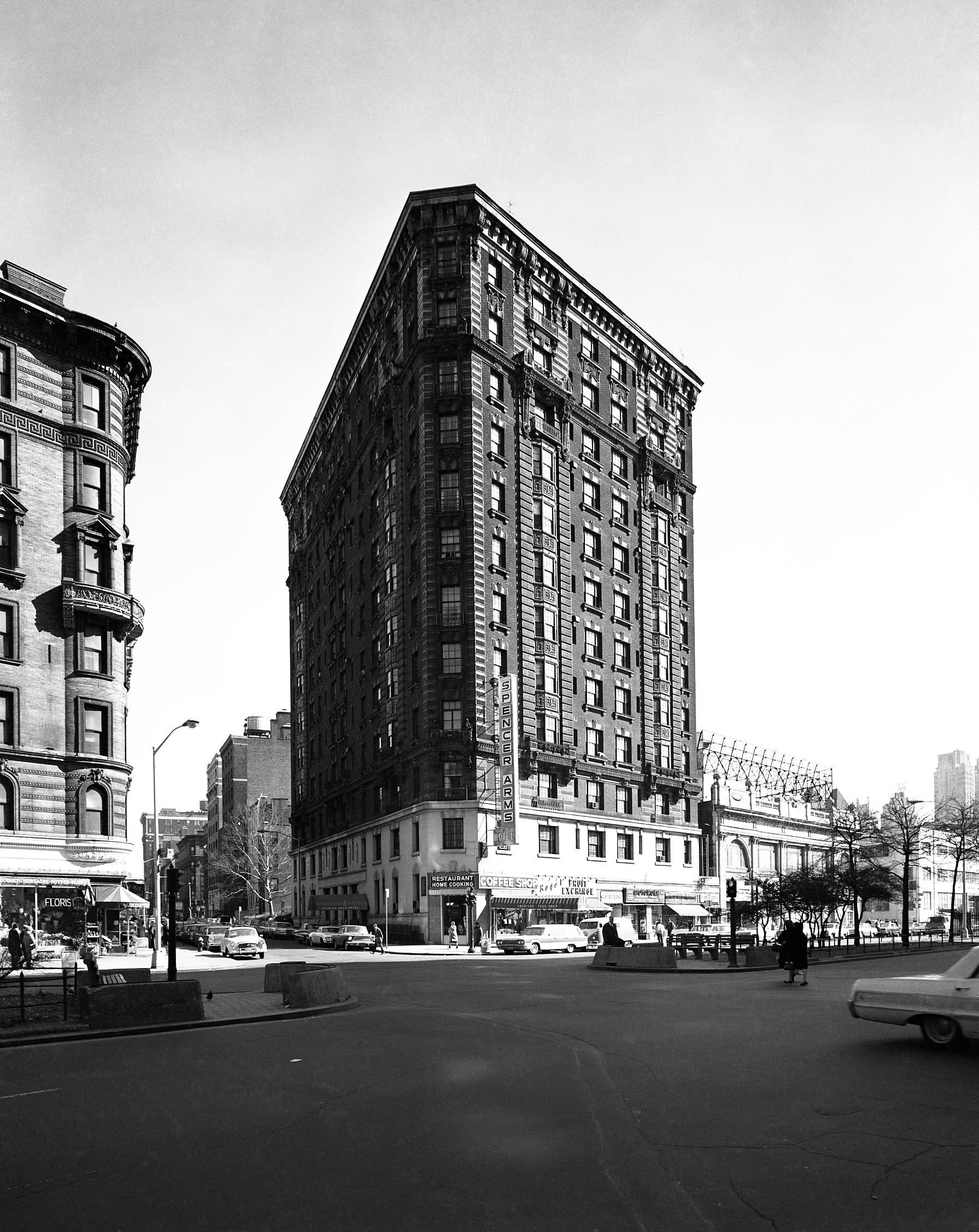
2012-2018 Broadway, The Spencer Arms
by Tom Miller
In 1904 the architectural firm of Mulliken & Moeller designed a 12-story residential hotel building for the Spencer Realty Company. Located at the southeast corner of Broadway and 69th Street, the architects handled the trapezoidal plot by chamfering the sharp point at the corner. Their Beaux Arts design featured a two-story stone base and ten stories of red brick trimmed in limestone. Quoins and angled metal bays stressed the verticality of the structure, while frothy French carvings and iron balconettes gave the Spencer Arms a slightly Parisian flair.
The Evening World said the Spencer Arms “is considered one of the most complete modern apartments in Manhattan.” There were 100 “non-housekeeping apartments” (meaning they had no kitchens) in the building. Rents range from $2,300 to $4,000 per year (about $12,000 per month by 2024 conversions).
Among the initial residents were Harry S. Houpt and his wife, Eleanor. Houpt was, not coincidentally, the treasurer of the Spencer Realty Co. The couple’s summer home was in Deal, New Jersey. Houpt was perhaps as well-known for his love of motorcars as he was for real estate dealings. Even Eleanor was an accomplished driver and owned a Thomas Flyer—an electric two-seater manufactured by Rauch & Lang. Eleanor Houpt was well-respected in the pedigree show dog circuit. In 1906, she had ten Boston Terriers listed with the National American Kennel Club, all of them named after a precious gem—Houpt’s Diamond, Houpt’s Emerald, and Houpt’s Opal, for instance.
Other early residents were attorney Charles Augustus Hess, his wife, the former Ida Doctor, and their son Jerome Sayles Hess. Hess graduated from the New York University Law School in 1879 and was an Assistant United States Attorney in 1883-84. He now ran his own legal firm. Jerome, who graduated from Yale in 1903, was an attorney in his father’s office. Charles Hess died in his apartment on October 26, 1907, at the age of 49.
The next afternoon Emma Adler visited and, realizing that her friend was seriously ill, called her doctor.
The George Powell Benjamin family were especially visible socially. Benjamin’s first wife, Julia De Forest, died in 1886. He moved into the Spencer Arms with his daughter, Julia. George was married to Elise J. Cordin in Grace Church on September 18, 1907. The groom was 57 and his bride was 36. The New York Times reported that upon returning from their honeymoon, the couple “will reside at the Spencer Arms, 140 West Sixty-ninth Street.”
The newlyweds may have cut their trip short because of Julie’s debut. On November 14, 1907, The New York Times reported, “Mrs. George Powell Benjamin will give a reception on Dec. 7 at her home, 140 West Sixty-ninth Street, to introduce her daughter, Miss Julia de Forest Benjamin.” Julia quickly assimilated into the swirl of society. On December 27, 1908, for instance, The New York Times reported, “Yesterday afternoon Mrs. George Powell Benjamin and Miss Julie De Forest Benjamin of 140 West Sixty-ninth Street gave the last of a series of at-homes.”
Another socially prominent resident was Emma Fechheimer Adler. The widow of Charles Everett Adler, she moved to New York with her two daughters, Lillian and Irene, from San Francisco. On March 8, 1907, The New York Times reported that she “gave a large luncheon yesterday in honor of Mrs. McVickar, a sister-in-law of the bishop of Rhode Island.”
Emma Adler was drawn into a mystery in 1910. Lucille Clerk, described by The New York Times as “a young Englishwoman of good family,” arrived in New York “with a letter of introduction from Lady Hastings of London to Mrs. Jordan Smith.” Mrs. Smith introduced Lucille Clerk to her friends, including Emma Adler. The two women became friendly.
On the night of February 16, 1910, Lucille Clerk had dinner with friends and upon returning to the Grenoble Hotel became ill. The next afternoon Emma Adler visited and, realizing that her friend was seriously ill, called her doctor. Dr. Oastler, in turn, brought in two others. Emma returned the following day. A nurse had been hired and “Miss Clerk was very low,” Emma told investigators later. Julia Clerk died that afternoon. Emma Adler was questioned at length by investigators. The New York Times quoted her as saying, “I have no idea why she died, and do not think it could have been suicide, as she was in good health and the best of spirits.” The cause of death does not appear to have ever been discovered.
Resident Henry Van Schaick had an interesting background. Born in 1825 the son of Myndert Van Schaick, he was “a descendant of one of New York’s oldest families,” according to The New York Times. His ancestors had settled in New Amsterdam in the 17th century. He was related to European nobility through his daughter, Elise, who married Count Alexander Boutourline of Germany. His granddaughter, Countess Linka, married Count Albert Hohenau. Van Schaick died in his apartment at the age of 89 on November 14, 1914.
Perhaps the most colorful resident was German spy Marie K. de Victorica. The daughter of a Prussian general, she was arrested in April 1918 and dubbed by the New York press “the Blonde Mata Hari.” She testified against the other members of the spy ring on February 10, 1919. The New-York Tribune described her as “a product of the Bismarck school of Teutonic intrigue,” and said she “created a sensation when she appeared in court.” The fashionable agent “wore a Hudson seal coat trimmed with sable, a black velvet dress over satin and a large black beaver picture hat with gourah feathers. She also wore a moonstone necklace and diamond rings.”
She testified that she had arrived in the United States on January 21, 1917 and moved into the Waldorf-Astoria, after which she took an apartment in the Spencer Arms. She would obtain sensitive intelligence that would be tucked into a newspaper and left in a particular pew in St. Patrick’s Cathedral. Asked why she gave up her apartment in the Spencer Arms and moved to Long Beach, New Jersey, she said she was told “they could come and ransack my apartment when I was absent, and it was better for me to live at a hotel.”
The extended Kahn family lived in the Spencer Arms by 1922. Max Kahn received his Ph.D. from Columbia in 1912 and was an associate in biological chemistry at the Columbia University School of Medicine. He and his wife, the former Ray Gertrude Wattman, had two sons, Morris and Samuel.
Dr. Morris H. Kahn graduated from Cornell University and was Chief of the Department of Cardiovascular Diseases at Beth Israel Hospital. Samuel Kahn was also a physician. On September 6, 1922, the New York Medical Journal noted that he “sailed on the Majestic, August 22nd, for an extended trip abroad.” As it turned out, there was more to the voyage than anyone knew. The following year, on June 25, 1923, the Brooklyn Standard Union ran the headline, “Wife Too Friendly With M.D., He Says.” The article told of the divorce proceedings of Henry A. and Alicia Solomon. Henry accused his wife of being “interested in Dr. Samuel Kahn,” and said that when Alicia returned from Europe the previous year, “she admitted having met Dr. Kahn in Vienna and said she had been ‘weak and unable to resist his advances.’”
In 1912 the couple was returning from Europe on the new ocean liner the RMS Titanic.
Max Kahn’s name appeared in the newspapers for a much less salacious reason that year. On September 20, The Toronto Star reported that he had discovered a treatment for diabetes, “Intarvin.” The article said, “most doctors in New York who are familiar with the new treatment are eloquent in its praise.”
Irene Harris (who preferred to be known as Renee) was the widow of theater producer Henry Birkhardt Harris. In 1912 the couple was returning from Europe on the new ocean liner the RMS Titanic. While living here, she recalled that horrible April morning when her husband insisted she climb into the last lifeboat against her wishes. As the lifeboat was lowered, Isadore Straus told her, “God go with you.” Back in New York, Renee Harris took over her husband’s business, becoming the first female theatrical producer in New York. She died in 1969 at the age of 93.
Not all the residents of the Spencer Arms were upstanding by the 1970s. In April 1975 Gregory Gary was arrested for a triple murder, and in February 1979 David Tzachuasvili was incarcerated, albeit for a much less serious crime. The 27-year-old cabbie had charged two Iranian tourists $175 for a one-mile ride to Kennedy Airport. He was charged with grand larceny.
In 1993 the building was renovated and converted to a cooperative, now called the Lincoln Spencer Arms.
Tom Miller is a social historian and blogger at daytoninmanhattan.blogspot.com
BUILDING DATABASE
Keep Exploring
Be a part of history!
Think Local First to support the businesses at 2012-2018 Broadway/140 West 69th Street:
Meet Tiga McLoyd!




